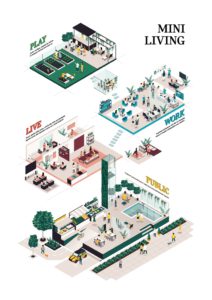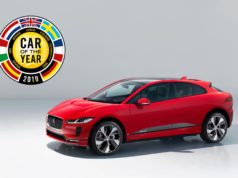As urbanisation continues to gather pace, attractive living spaces in large cities are becoming increasingly sparse. Indeed, more people than ever are living within a shrinking footprint. With MINI LIVING, MINI is addressing these developments and creating the first co-living project in China. MINI is working with Chinese project developer Nova Property Investment Co. to transform an unused industrial complex in the Jing’An district of Shanghai into a multi-layered co-living initiative made up of apartments, working spaces and cultural/leisure offerings. The conversion work is slated to begin before the end of this year.
 Launched in 2016, MINI LIVING has explored new kinds of living concepts which seek to maximise the quality of life within minimal spaces – all in keeping with the brand’s “Creative Use of Space” motto. The project in Shanghai sees MINI translating the concept idea encapsulated by its previous installations into an actual building project for the first time. A former paint factory will be transformed into an urban hotspot with generous space for working, interaction and living. Here, MINI LIVING will offer apartments, bookable workspaces and services such as vehicles for shared use as part of a concept enabling maximum personal flexibility and optimum use of space. The MINI LIVING idea that we get more when we share applies not only to the building’s residents but those of the city as a whole. Indeed, parts of the MINI LIVING complex will be accessible to the wider public.
Launched in 2016, MINI LIVING has explored new kinds of living concepts which seek to maximise the quality of life within minimal spaces – all in keeping with the brand’s “Creative Use of Space” motto. The project in Shanghai sees MINI translating the concept idea encapsulated by its previous installations into an actual building project for the first time. A former paint factory will be transformed into an urban hotspot with generous space for working, interaction and living. Here, MINI LIVING will offer apartments, bookable workspaces and services such as vehicles for shared use as part of a concept enabling maximum personal flexibility and optimum use of space. The MINI LIVING idea that we get more when we share applies not only to the building’s residents but those of the city as a whole. Indeed, parts of the MINI LIVING complex will be accessible to the wider public.
“MINI has always been an urban brand. It not only has its finger on the pulse of the city, it injects that pulse with extra energy,” explains Peter Schwarzenbauer, Member of the Board of Management of BMW AG, responsible for MINI, Rolls-Royce, BMW Motorrad, Customer Experience and Digital Business Innovation BMW Group.
“At MINI we are also well versed in the intelligent use of space; back in 1959, the classic Mini was already maximising the experience available within a very small footprint. MINI LIVING brings this know-how from the vehicles we drive into the places where we live. We are rethinking the idea of living space in the city and developing attractive, need-oriented living concepts. Our aim here is to offer an extremely high quality of life within an extremely small area.” Peter Schwarzenbauer signed the contract with Nova Property at MINI’s Urban Matters brand event in Shanghai at the start of November.
 MINI LIVING is about more than where you live
MINI LIVING is about more than where you live
An innovative co-living concept is the base of the MINI LIVING project in Shanghai. In an up-and-coming area of the well developed Jing’An district in the centre of the city, a cluster of six buildings will be turned into a vibrant urban neighbourhood. MINI LIVING will become a home for singles, sharers and families on short, medium-term and extended tenancies. The design and therefore the character of the apartment interiors is international, modern and clean, and features references to the history of Shanghai. However, living in an apartment that occupies only a small surface area in no way means going without. People can move into the adjacent spaces anything that doesn’t fit inside the apartments (activities or objects).
 MINI LIVING offers room to experience community as well
MINI LIVING offers room to experience community as well
Generously sized lobbies provide an excellent place to just hang out. Exhibition areas and a food market invite a closer look. The available facilities also include gardens, play areas, shops and restaurants, which people living elsewhere in Shanghai will be welcome to access too. MINI LIVING is keen to promote social interaction. Not only among the residents themselves but with people from other parts of the city. After all, one of the key aims of MINI LIVING is to bring people together and encourage shared experiences.
“With MINI LIVING we’re looking to create a genuine alternative within the rental market of big cities,” says Esther Bahne, Head of MINI Brand Strategy and Business Innovation. “We’re offering a place that can adapt to its residents, is flexible and allows room to breathe. MINI LIVING gives residents their privacy but also enables them to engage with a variety of different people. It makes those first steps into a new city that much smoother. The idea is that our residents really feel at home here.”
In addition to the space itself, the project also comprises additional services – they are digitally accessible. For example, residents can make restaurant reservations, book room cleaning and service, order food and rent mobility options. So MINI LIVING not only demonstrates an intelligent use of space. But it also offers scope for individualisation and a range of digital services.
The future of MINI is here… #Electric pic.twitter.com/nSFy6craSM
— Snows MINI (@SnowsMINI) November 11, 2017

































